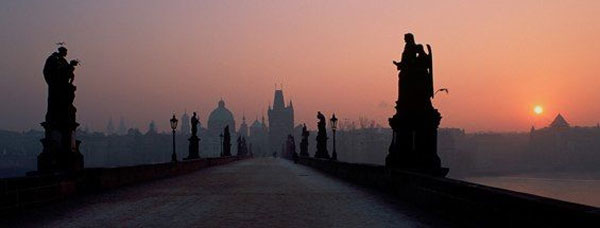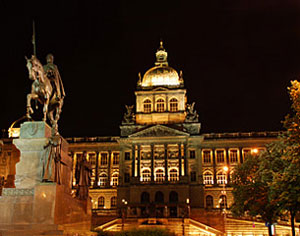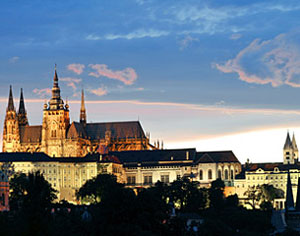Reply To:
Name - Reply Comment

Since the fall of the Iron Curtain, Prague has become one of Europe's most popular tourist destinations and is now the sixth most-visited European city after London, Paris, Rome, Madrid and Berlin.
The capital of the new Czech Republic since the separation of Czechoslovakia in 1993, Prague suffered less damage during World War II than other major regional cities, allowing most of its historic architecture to remain intact. As a result the city contains a vast array of well-preserved architecture, comprising Art Nouveau, Baroque, Renaissance, Gothic, Neo-Classical and ultra-modern genres.
The ‘City of One Hundred Spires’ (500 at the latest count) is a magical city of bridges, cathedrals, and gold-tipped towers. Its compact medieval centre remains a wonderful mixture of cobbled lanes, walled courtyards, and church spires, all in the shadow of a majestic 9th century castle.
Modern day Prague is a vibrant city full of energy, music, culture and art, and welcomes more than 4.1 million visitors every year, each keen to experience the charms of Eastern Europe.
 Attractions
Attractions
Central Prague is small enough to sightsee on foot and makes for a fascinating tour at street level. Take a circular tour of Prague, starting at the Nationale-Nederlanden building. Designed by architect Frank Gehry, it’s more often known as Fred & Ginger as it resembles a pair of dancers. Cross the Vltava River and enjoy a 2-km wander through the beautiful streets and old churches of the historic Lesser Town. Detour via the nearby funicular to Petřín Park, a 318-metre hill complete with 60-metre observation tower which afford superb views of the city’s red rooftops and Prague Castle.
Back at river level; continue along the cobbled streets to one of the city’s three Churches of St. Nicholas. The adjacent Lesser Town Square is lined with parking meters which look like Easter Island statues, and lead towards the quaint New Steps which ascend to Prague Castle. The castle perches atop a hill and its huge courtyards, fountains and ornate architecture takes some time to comprehend. At the heart is St. Vitus, a spiky gothic cathedral adorned with gilded clocks, murals and gargoyles, and patrolled by Rayban-wearing guards.
Descend the Old Steps towards the river and head east across the iconic (but touristy) Charles Bridge. At the far end you’ll find the UNESCO World Heritage Site of the medieval Old Town – home to the Town Square, Astronomical Clock, Tyn Cathedral and Powder Tower. Finally, end your tour at the far end of Wenceslas Square; its Neo-Renaissance National Museum is less than a kilometre from where you began.
 Dining and Nightlife
Dining and Nightlife
Prague has no end of international dining options, and there is a wide range of restaurants, cafés, bars, taverns and pubs to choose from. Central Prague restaurants tend to be slightly overpriced and a little touristy, so ask around for the best local suggestions.
Classic Czech cuisine revolves heavily around meat and starch. Characteristic dishes comprise schnitzel with cabbage and dumplings, sirloin of beef with tomato, dill and dumplings, and beef gulash with dumplings. Desserts include fruit dumplings strewn with cottage cheese and sugar, or the famous (and dumpling-free) Bohemian and Moravian cakes.
Prague nightlife is legendary, and during the 1990s the city garnered a reputation for hosting numerous English stag dos due to its remarkably cheap beer – unsurprisingly as nearby Plzeň is the birthplace of lager. As tourism has taken off and exchange rates have altered, the Czech national drink has become comparatively less cheap and the city has reclaimed its streets from the lager louts. Today the city features a lively nightlife, mainly centred on pubs (hospoda) and late night clubs in the Old Town.
Beyond Prague
Fifty kilometres south of Prague is Konopiste Castle, the 19th century ex-residence of the Archduke Franz Ferdinand, heir to the Hapsburg throne. While Ferdinand was waiting to accede to the throne, he amassed one of the best collections of weaponry in the world – which is still on display. He certainly had time to do so: his uncle, Emperor Franz Josef, remained in power from 1848 to 1916. In 1914, just two years before he would have become Emperor, Ferdinand was assassinated, sparking World War I.
Emirates operates daily flights to Prague from our Dubai hub using a state-of-the-art fleet. Discover Emirates comfortable in-flight offerings on Prague flights, which include spacious sleeperettes in Business Class and extra legroom in Economy Class. All classes feature ice, Emirates onboard information, communication and entertainment system offering up to 1,400 channels, making flights to Prague pass quickly.